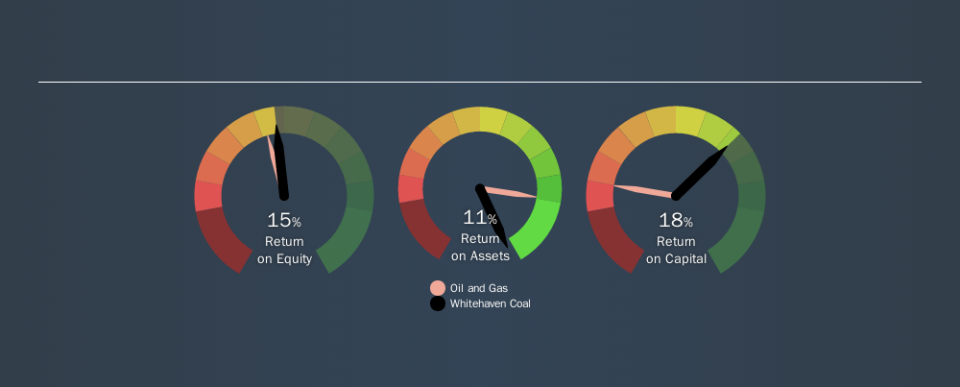Are Whitehaven Coal Limited’s (ASX:WHC) High Returns Really That Great?

Today we'll evaluate Whitehaven Coal Limited (ASX:WHC) to determine whether it could have potential as an investment idea. Specifically, we'll consider its Return On Capital Employed (ROCE), since that will give us an insight into how efficiently the business can generate profits from the capital it requires.
First, we'll go over how we calculate ROCE. Second, we'll look at its ROCE compared to similar companies. Last but not least, we'll look at what impact its current liabilities have on its ROCE.
What is Return On Capital Employed (ROCE)?
ROCE measures the amount of pre-tax profits a company can generate from the capital employed in its business. Generally speaking a higher ROCE is better. Overall, it is a valuable metric that has its flaws. Renowned investment researcher Michael Mauboussin has suggested that a high ROCE can indicate that 'one dollar invested in the company generates value of more than one dollar'.
How Do You Calculate Return On Capital Employed?
The formula for calculating the return on capital employed is:
Return on Capital Employed = Earnings Before Interest and Tax (EBIT) ÷ (Total Assets - Current Liabilities)
Or for Whitehaven Coal:
0.18 = AU$789m ÷ (AU$4.8b - AU$339m) (Based on the trailing twelve months to June 2019.)
So, Whitehaven Coal has an ROCE of 18%.
View our latest analysis for Whitehaven Coal
Does Whitehaven Coal Have A Good ROCE?
When making comparisons between similar businesses, investors may find ROCE useful. Using our data, we find that Whitehaven Coal's ROCE is meaningfully better than the 11% average in the Oil and Gas industry. We consider this a positive sign, because it suggests it uses capital more efficiently than similar companies. Independently of how Whitehaven Coal compares to its industry, its ROCE in absolute terms appears decent, and the company may be worthy of closer investigation.
In our analysis, Whitehaven Coal's ROCE appears to be 18%, compared to 3 years ago, when its ROCE was 2.3%. This makes us wonder if the company is improving. You can click on the image below to see (in greater detail) how Whitehaven Coal's past growth compares to other companies.
Remember that this metric is backwards looking - it shows what has happened in the past, and does not accurately predict the future. Companies in cyclical industries can be difficult to understand using ROCE, as returns typically look high during boom times, and low during busts. ROCE is, after all, simply a snap shot of a single year. Given the industry it operates in, Whitehaven Coal could be considered cyclical. Future performance is what matters, and you can see analyst predictions in our free report on analyst forecasts for the company.
Whitehaven Coal's Current Liabilities And Their Impact On Its ROCE
Current liabilities include invoices, such as supplier payments, short-term debt, or a tax bill, that need to be paid within 12 months. Due to the way the ROCE equation works, having large bills due in the near term can make it look as though a company has less capital employed, and thus a higher ROCE than usual. To counteract this, we check if a company has high current liabilities, relative to its total assets.
Whitehaven Coal has total liabilities of AU$339m and total assets of AU$4.8b. As a result, its current liabilities are equal to approximately 7.0% of its total assets. Low current liabilities have only a minimal impact on Whitehaven Coal's ROCE, making its decent returns more credible.
Our Take On Whitehaven Coal's ROCE
This is good to see, and while better prospects may exist, Whitehaven Coal seems worth researching further. Whitehaven Coal shapes up well under this analysis, but it is far from the only business delivering excellent numbers . You might also want to check this free collection of companies delivering excellent earnings growth.
I will like Whitehaven Coal better if I see some big insider buys. While we wait, check out this free list of growing companies with considerable, recent, insider buying.
We aim to bring you long-term focused research analysis driven by fundamental data. Note that our analysis may not factor in the latest price-sensitive company announcements or qualitative material.
If you spot an error that warrants correction, please contact the editor at editorial-team@simplywallst.com. This article by Simply Wall St is general in nature. It does not constitute a recommendation to buy or sell any stock, and does not take account of your objectives, or your financial situation. Simply Wall St has no position in the stocks mentioned. Thank you for reading.

